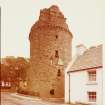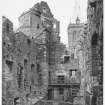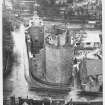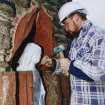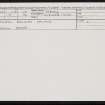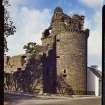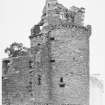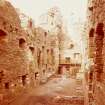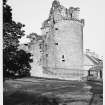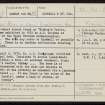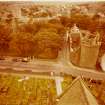Kirkwall, Bishops Palace
Brooch (Roman), Finger Ring (Gold)(Period Unassigned)
Site Name Kirkwall, Bishops Palace
Classification Brooch (Roman), Finger Ring (Gold)(Period Unassigned)
Alternative Name(s) Bishop's Castle
Canmore ID 2526
Site Number HY41SW 18
NGR HY 44 10
NGR Description HY c. 44 10
Datum OSGB36 - NGR
Permalink http://canmore.org.uk/site/2526
- Council Orkney Islands
- Parish Kirkwall And St Ola
- Former Region Orkney Islands Area
- Former District Orkney
- Former County Orkney
HY41SW 18 c. 44 10.
A Roman trumpet brooch found at 'Bishop's Castle, Orkney' was exhibited in 1872 by A G Geoghan at a meeting of the Royal British Archaeological. Institute. (anon, J Archaeol Inst). The site may refer to Kirkwall or possibly to Birsay. There is no further information relating to this find.
G Macdonald 1932.
On April 5, 1872, Mr A G Geoghegan exhibited to the Royal Arch Institute 'a bronze spear-head; A Roman fibula; a boss, or personal ornament, found at Bishop's Castle, Orkney .... The boss is of silver, ornamented with the rose and thistle in high relief; it was probably an ornament for a leathern belt or shield ... It was found in the ruins of the 'Bishop's Castle', under a heap of stones, at Kirkwall, Orkney'.
Archaeol J 1872.
2nd century AD Trumpet brooch from the Bishop's Palace, Kirkwall, now in National Museum of Antiquities of Scotland (NMAS).
A S Robertson 1970.
Medieval finger ring HY 44 10 Large gold finger ring originally intended to hold an unshaped gemstone, now missing. The rudimentary nature of medieval gem cutting meant that a ring was often designed around an existing uncut gem rather than the gem being cut to fit the bezel. In general appearance and method of construction the Kirkwall ring can be paralleled with a wider class of European finger rings of the 13th and 14th centuries, although a useful Scottish parallel
is a similar ring from the Meal Vennel and Scott Street excavations in Perth (PSAS 1997).
Claimed as Treasure Trove (TT.11/05) and allocated to Orkney Museum.
S Campbell 2005
Publication Account (1981)
In Hakon Hakonson's Saga we are informed that the dying king came to the bishop's palace, which would indicate the existence of such a building as early as 1263. Indeed, W. Douglas Simpson dated some of the primary masonry of the Palace to the mid-twelfth century (1961, 70). Major sections of the Palace are datable from the fifteenth and sixteenth centuries, with much alteration done by Bishop Reid about 1550, including the construction of a large round defensive tower, embattled and pierced for guns (Simpson, 1961, 73). A tower which existed in Barry's time, the square Mense, or Mass tower, is now gone (RCAM, 1946, II, 145). Although through the centuries reconstructed several times, the Bishop's Palace is now quite ruinous, its roof presumably sold in the eighteenth century.
Information from ‘Historic Kirkwall: The Archaeological Implications of Development’ (1977).




















